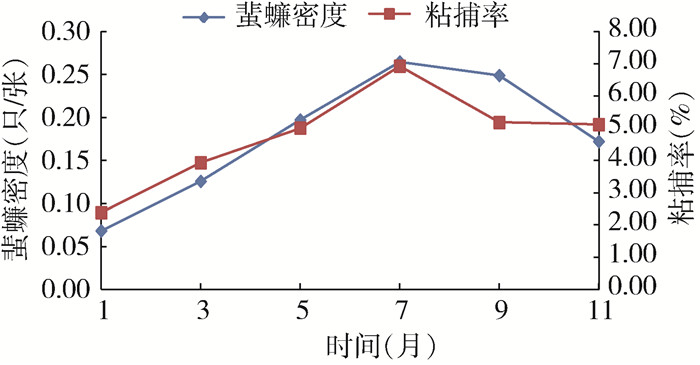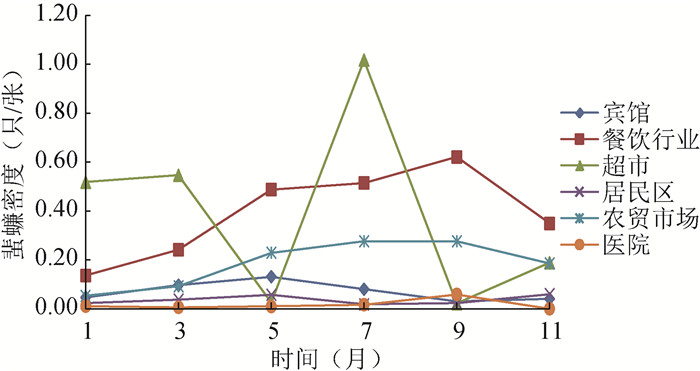扩展功能
文章信息
- 李广帅, 陈保忠, 雷晓岗, 薛威, 庞松涛
- LI Guang-shuai, CHEN Bao-zhong, LEI Xiao-gang, XUE Wei, PANG Song-tao
- 西安市2015-2018年蜚蠊监测结果分析
- An analysis of cockroach surveillance results in Xi'an, Shaanxi province, China, 2015-2018
- 中国媒介生物学及控制杂志, 2020, 31(4): 481-485
- Chin J Vector Biol & Control, 2020, 31(4): 481-485
- 10.11853/j.issn.1003.8280.2020.04.022
-
文章历史
- 收稿日期: 2020-02-21
蜚蠊作为与人们生活关系密切的病媒生物,体内外不仅携带多种细菌、病毒、真菌和寄生虫卵,其排泄物、尸体、分泌物还会造成人体过敏反应[1-2],引发哮喘等疾病[3]。研究发现,西安市德国小蠊(Blattella germanica)带病毒情况较为严重[4]。因此调查掌握蜚蠊种类、密度、粘捕率、分布特点及季节消长等情况,对预防控制蜚蠊及所致疾病有着至关重要的作用。2015-2018年西安市继续按照病媒生物密度监测方案开展蜚蠊现场监测,现将结果报告如下。
1 材料与方法 1.1 监测点的选择按照西安市东、南、西、北4个方位,共选择6个区(县),兼顾城区和郊区。每个区(县)选择6个监测点,包括宾馆、餐饮行业、超市、居民区、农贸市场和医院,排除1周内药物处理过的场所。
1.2 材料粘蟑纸统一选用的规格为17 cm×10 cm,由北京绿叶世纪日化用品有限公司生产。
1.3 监测方法采用粘捕法,奇数月中旬进行监测。将2 g左右的新鲜面包放置于粘蟑纸中间位置,布放于蜚蠊经常活动、取食的地方,晚放晨收。每个标准间(约15 m2)布放1张,居民厨房布放1张。每次监测时,均使用新的粘蟑纸[5]。
1.4 统计学分析每次监测后,现场登记粘捕到的蜚蠊种类,记录成虫性别及若虫数量,记录回收的粘蟑纸数。雌成虫、雄成虫、若虫总数为捕获蜚蠊总数。将数据录入Excel 2010软件计算蜚蠊密度和粘捕率,使用SPSS 13.0软件,蜚蠊密度和粘捕率之间采用Pearson相关性检验,城区和郊区成虫性别之间采用χ2检验,城区和郊区之间各月平均密度与粘捕率采用t检验进行统计学分析,检验水准α=0.05。

|
2015-2018年共布放粘蟑纸15 935张,回收15 501张,回收率为97.28%。阳性粘蟑纸数731张,捕获蜚蠊总数2 742只,经鉴定美洲大蠊(Periplaneta americana)2只,其余均为德国小蠊,其中雌成虫为1 391只,雄成虫为709只,若虫为642只,蜚蠊平均密度为0.18只/张,平均粘捕率为4.72%。2015年蜚蠊密度和粘捕率均最高,之后基本呈逐年下降趋势,见表 1。
在各生境中,蜚蠊密度和粘捕率最高的是餐饮行业,分别为0.40只/张和8.85%,最低的是医院,分别为0.02只/张和0.60%。除居民区外,其余生境雌成虫捕获量均高于雄成虫,见表 2。

|
各月蜚蠊平均密度和平均粘捕率均呈单峰趋势,在7月达到最高,分别为0.26只/张和6.93%。经Pearson相关性检验,各月平均密度和平均粘捕率有相关性(r2=0.933,P=0.006),见图 1。

|
| 图 1 2015-2018年西安市蜚蠊密度和粘捕率季节消长情况 Figure 1 Seasonal trend of cockroach density and sticky trapping rate in Xi′an, 2015-2018 |
| |
各生境蜚蠊密度监测发现,超市呈现剧烈波动,7月为最高峰,5和9月为低谷期;餐饮行业呈现单峰趋势,9月为高峰期;农贸市场在5月以后一直处于相对高水平状态;宾馆、超市、医院等生境变化趋势不大,保持低水平状态,见图 2。

|
| 图 2 2015-2018年西安市不同生境蜚蠊密度季节消长情况 Figure 2 Seasonal trend of cockroach density in different habitats in Xi′an, 2015-2018 |
| |
各生境粘捕率结果显示,超市呈现剧烈波动,7月为高峰期,5和9月为低谷期,餐饮行业和农贸市场呈现单峰趋势,7月为最高峰;宾馆呈现双峰趋势,分别在5和11月有2个高峰,见图 3。

|
| 图 3 2015-2018年西安市不同生境蜚蠊粘捕率季节变化情况 Figure 3 Seasonal trend of cockroach sticky trapping rate in different habitats in Xi′an,2015-2018 |
| |
城区及郊区成虫性别间经χ2检验,差异有统计学意义(χ2=166.467,P<0.001);城区及郊区各月平均蜚蠊密度经t检验,差异无统计学意义(t=-1.221,P=0.250);城区及郊区的各月平均粘捕率经t检验,差异亦无统计学意义(t=-1.204,P=0.256),见表 3、4。

|

|
西安市地处关中平原中部,冷暖干湿四季分明,野外环境并不适宜蜚蠊的繁殖和越冬[6],但是随着城镇化的发展,更多适宜的室内小气候为其繁殖和越冬提供了条件。2015-2018年西安市监测发现蜚蠊密度低于全国平均水平,稍高于陕西省平均水平[7]。与西安市2012-2015年相比,蜚蠊密度和粘捕率有大幅下降[8],且呈逐年下降趋势,可能与2015年西安市创建国家卫生城市有关,全市卫生环境有了很大提升,其他城市创卫后也存在类似情况[9],这也说明卫生城市创建对于全市环境卫生的改善有显著效果。蜚蠊密度和粘捕率的大幅下降也导致一些种类很难被捕获,故2015-2018年监测发现德国小蠊占绝对优势,种群分布与兰州市情况非常相似[10],与武汉、南京市有所差异,可能与当地气候条件有关[11-12]。
各生境监测结果显示,餐饮行业是危害最严重的场所,与全国及西安市2012-2015年监测结果基本一致[7-8],仍需重点关注;农贸市场蜚蠊密度相对不高,但粘捕率很高,可能是其摊位多为临时性且经常搬动不利于蜚蠊栖息,市场内买菜市民携物走动频繁,利于蜚蠊或卵的扩散,由此提示,市民也存在将蜚蠊或卵携带至家中的机会,郭礼梁和陈隼[13]研究也提到,因此应对市民进行健康教育,防止将蜚蠊或卵带入家中。季节消长趋势显示,7月蜚蠊密度和粘捕率均是最高峰,与全国结果有所差别[7],与泰安和东营市监测结果基本一致[14-15],可能是这些地区气候条件类似,蜚蠊的生活习性也趋于一致。
不同生境季节消长趋势显示超市波动较大,且危害较为严重,经调查了解超市很少长期聘请专业消杀公司,只在高峰来临之前请专业人员进行一次彻底杀灭和卫生整治,之后不再坚持,在密度升高之后再进行一次,可能是由于超市售卖熟食、散装食品的区域往往紧靠室外废弃食品放置区,极易将室外蜚蠊吸引进来所致。因此建议超市至少为熟食和散装食品区经营户长期聘请专业消杀公司,使蜚蠊密度和粘捕率保持在较低水平。餐饮行业和农贸市场与山东省、北京市等地基本一致,在5-9月蜚蠊密度和粘捕率保持在较高水平,是需重点关注场所[16-17]。统计分析发现粘捕率随蜚蠊密度增高而增高,具有很大相关性;城区和郊区蜚蠊危害差别不大,但是郊区雌成虫构成比远高于城区。
蜚蠊生命力顽强,适应能力强,防制难度大,尤其是西安市蜚蠊带病毒率较高[4],虽然密度和粘捕率处于低水平,但不能掉以轻心。由于目前化学杀虫剂的滥用,蜚蠊对常用杀虫剂有不同程度的抗药性[8, 12],因此在制定防制措施时应根据监测结果,因时、因地制定有针对性的综合性措施,并由有害生物防治公司提供专业化防制手段,疾病控制部门加强监督管理[18],才能收到更好的杀灭效果。
| [1] |
钟少琴, 张志忍, 赖晓娟, 等. 2974例慢性荨麻疹皮肤点刺试验结果分析[J]. 广州医药, 2019, 50(2): 104-106. Zhong SQ, Zhang ZR, Lai XJ, et al. Analysis of skin prick test results of 2974 cases of chronic urticaria[J]. Guangzhou Med J, 2019, 50(2): 104-106. DOI:10.3969/j.issn.1000-8535.2019.02.028 |
| [2] |
王小勇. 鹤壁市471例过敏性疾病患儿过敏原检测分析[J]. 青岛医药卫生, 2019, 51(2): 154-156. Wang XY. Detection and analysis of allergens in 471 children with allergic diseases in Hebi city[J]. Qingdao Med J, 2019, 51(2): 154-156. DOI:10.3969/j.issn.1006-5571.2019.02.022 |
| [3] |
陆宝麟, 吴厚永. 中国重要医学昆虫分类与鉴别[M]. 郑州: 河南科学技术出版社, 2003: 621-622. Lu BL, Wu HY. Classification and identification of important medical insects of China[M]. Zhengzhou: Henan Science and Technology Publishing House, 2003: 621-622. |
| [4] |
杜全丽, 王欣, 庞松涛, 等. 西安市德国小蠊携带病毒调查[J]. 中华卫生杀虫药械, 2018, 24(1): 59-61. Du QL, Wang X, Pang ST, et al. Virus detection from Blattella germanica collected in Xi'an city[J]. Chin J Hyg Insect Equip, 2018, 24(1): 59-61. DOI:10.19821/j.1671-2781.2018.01.018 |
| [5] |
中国疾病预防控制中心.全国病媒生物监测实施方案[Z].北京: 中国疾病预防控制中心, 2016. Chinese Center for Disease Control and Prevention. Nationl vector surveillance implementation plan[Z]. Beijing: Chinese Center for Disease Control and Prevention, 2016. |
| [6] |
叶青, 夏时畅. 病媒生物综合防制技术指南[M]. 杭州: 浙江大学出版社, 2012: 125-126. Ye Q, Xia SC. Technical guidelines for integrated vector control[M]. Hangzhou: Zhejiang University Press, 2012: 125-126. |
| [7] |
任东升, 吴海霞, 郭玉红, 等. 2018年全国蜚蠊监测报告[J]. 中国媒介生物学及控制杂志, 2019, 30(2): 142-145. Ren DS, Wu HX, Guo YH, et al. National vectors surveillance report on cockroaches in China, 2018[J]. Chin J Vector Biol Control, 2019, 30(2): 142-145. DOI:10.11853/j.issn.1003.8280.2019.02.006 |
| [8] |
雷晓岗, 庞松涛, 王欣, 等. 西安市2012-2015年蜚蠊危害状况及抗药性分析[J]. 中国媒介生物学及控制杂志, 2017, 28(3): 294-295, 303. Lei XG, Pang ST, Wang X, et al. Analysis of infestation and insecticide resistance of cockroaches in Xi'an city, 2012-2015[J]. Chin J Vector Biol Control, 2017, 28(3): 294-295, 303. DOI:10.11853/j.issn.1003.8280.2017.03.026 |
| [9] |
程时秀, 龚丽丽, 吕均, 等. 湖北省十堰市创建国家卫生城市前后病媒生物密度监测与分析[J]. 医学动物防制, 2019, 35(10): 1009-1011. Cheng SX, Gong LL, Lyu J, et al. Surveillance and analysis of vector density before and after the establishment of national health city in Shiyan city, Hubei province[J]. J Med Pest Control, 2019, 35(10): 1009-1011. DOI:10.7629/yxdwfz201910026 |
| [10] |
吴照, 杨丽, 刘旭红, 等. 兰州市2006-2015年蜚蠊监测结果分析[J]. 中国媒介生物学及控制杂志, 2018, 29(1): 91-93. Wu Z, Yang L, Liu XH, et al. Analysis on the cockroach surveillance in 2006-2015, Lanzhou city[J]. Chin J Vector Biol Control, 2018, 29(1): 91-93. DOI:10.11853/j.issn.1003.8280.2018.01.024 |
| [11] |
郭慧, 王高明, 鲁怡欣, 等. 武汉市2007-2016年蜚蠊监测结果分析[J]. 中国媒介生物学及控制杂志, 2018, 29(2): 168-171. Guo H, Wang GM, Lu YX, et al. Analysis of cockroach surveillance in Wuhan city from 2007 to 2016[J]. Chin J Vector Biol Control, 2018, 29(2): 168-171. DOI:10.11853/j.issn.1003.8280.2018.02.013 |
| [12] |
张守刚, 熊丽林, 孙燕群, 等. 南京市蟑螂密度监测及抗药性分析[J]. 中华卫生杀虫药械, 2018, 24(1): 20-23. Zhang SG, Xiong LL, Sun YQ, et al. Study on the density and insecticide resistance of cockroaches in Nanjing city[J]. Chin J Hyg Insect Equip, 2018, 24(1): 20-23. DOI:10.19821/j.1671-2781.2018.01.007 |
| [13] |
郭礼梁, 陈隼. 江苏省丹阳市2008-2015年蜚蠊密度监测结果分析[J]. 中国媒介生物学及控制杂志, 2018, 29(5): 502-504. Guo LL, Chen S. Analysis of cockroach surveillance in Danyang, Jiangsu during 2008 to 2015[J]. Chin J Vector Biol Control, 2018, 29(5): 502-504. DOI:10.11853/j.issn.1003.8280.2018.05.021 |
| [14] |
明明. 泰安市蟑螂密度季节消长及其抗药性分析[J]. 现代预防医学, 2016, 43(19): 3476-3478. Ming M. Seasonal fluctuation of cockroach density and its resistance, Tai'an city[J]. Mod Prev Med, 2016, 43(19): 3476-3478. |
| [15] |
刘辉, 房建村, 王海红. 东营市2016年蟑螂密度及侵害现状调查[J]. 中华卫生杀虫药械, 2017, 23(4): 365-367. Liu H, Fang JC, Wang HH. Investigation on the density and invasion situation of cockroaches in Dongying city in 2016[J]. Chin J Hyg Insect Equip, 2017, 23(4): 365-367. DOI:10.19821/j.1671-2781.2017.04.021 |
| [16] |
刘峰, 刘亚楠, 景晓, 等. 2010-2015年山东省居民区蟑螂监测分析[J]. 中华卫生杀虫药械, 2019, 25(2): 135-137. Liu F, Liu YN, Jing X, et al. Analysis on surveillance of cockroaches in residential areas in Shandong province from 2010 to 2015[J]. Chin J Hyg Insect Equip, 2019, 25(2): 135-137. DOI:10.19821/j.1671-2781.2019.02.013 |
| [17] |
付学锋, 周小洁. 2017年北京市居民家庭蟑螂侵害监测[J]. 首都公共卫生, 2019, 13(1): 46-48. Fu XF, Zhou XJ. Analysis of cockroach infestation rate surveillance in residential family in Beijing in 2017[J]. Cap J Public Health, 2019, 13(1): 46-48. DOI:10.16760/j.cnki.sdggws.2019.01.012 |
| [18] |
张家勇, 王纯玉, 丁俊, 等. 辽宁省2012-2016年蜚蠊监测结果分析[J]. 中国媒介生物学及控制杂志, 2019, 30(5): 550-553. Zhang JY, Wang CY, Ding J, et al. Analysis of surveillance on cockroach in Liaoning province from 2012 to 2016[J]. Chin J Vector Biol Control, 2019, 30(5): 550-553. DOI:10.11853/j.issn.1003.8280.2019.05.016 |
 2020, Vol. 31
2020, Vol. 31



